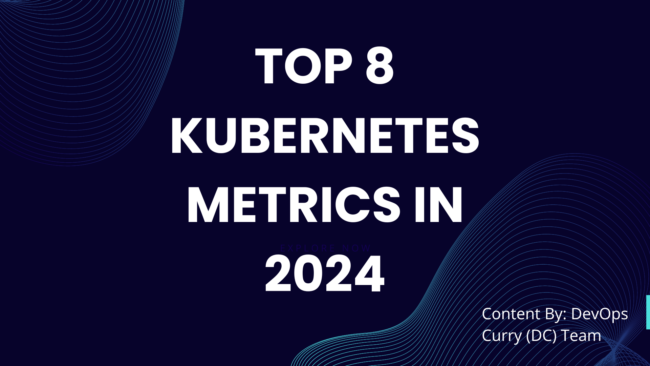Best 8 Kubernetes Metrics In 2024
Introduction Towards Kubernetes
The word Kubernetes means pilot or helmsman and it is originates from Ancient Greek. To handle, generate and configure the several applications on Kubernetes the Operators are created for particular applications.
Understand Kubernetes as per Wikipedia: Kubernetes commonly abbreviated K8s is an open-source container orchestration system for automating software deployment, scaling, and management. Originally designed by Google, the project is now maintained by a worldwide community of contributors, and the trademark is held by the Cloud Native Computing Foundation.
Kubernetes, often abbreviated as K8s, is an open-source container orchestration platform. It is designed to automate the deployment, scaling, and management of containerized applications. But what does that mean, and why is it such a big deal?
Imagine you’re running a bustling restaurant kitchen. Each dish is like a microservice in your software application. Every dish has its own ingredients and preparation steps. In simple words, Kubernetes is your seasoned sous-chef. It ensures every dish comes out perfectly, no matter how many orders flood in.
We have written many blog related to the topics Kubernetes, if you want to see more about it click on the given link https://devopscurry.com/managed-kubernetes-platform/
What is Kubernetes Metrics
Kubernetes plays a crucial role in the development of pods, providing essential data such as the number of sampled pods and various details from the components within a Kubernetes cluster. It is important for monitoring the health and performance of a Kubernetes cluster and these metrics provide a deep into the utilization of resources performance and behavior of the cluster’s components as like services, nodes and pods. Kubernetes metrics is also important for scalability, performance and reliability of your application. In this section, we will explore the top 8 Kubernetes metrics.
Top 8 Kubernetes Metrics You Need to Monitor
1. Kubernetes Cluster Metrics
Monitoring the Kubernetes cluster’s health and resource utilization is essential for maintaining visibility. Cluster metrics offer insights into resource usage, including memory, disk, and CPU usage. Additionally, it helps identify any resource contention issues within the cluster, ensuring efficient resource management for nodes, pods, and containers. In the other words we can also says that it is important for the health, performance and reliability of your infrastructure and application.
2. Kubernetes Node Metrics
Kubernetes Node Metrics provide valuable information about memory and CPU capacity for running pods. It also monitors network traffic on the nodes and tracks disk space usage, ensuring optimal node performance. It is important for understanding the performance and health of your cluster’s infrastructure. There are some tools such as Grafana and Prometheus, here you can gather, collect and visualize these metrics effectively. It will helps in optimize resources usage, address issues and help the reliability of your infrastructure.
3. Kubernetes Container Metrics
Metrics are essential when troubleshooting container-related issues. They aid in identifying and addressing problems within containers, including those that may require action or throttling. Three key container metrics to monitor are container CPU usage, container memory utilization, and network usage.
Container CPU Usage: This metric helps determine whether the container’s CPU usage is within its configured limits.
Container Memory Utilization: This metric assesses whether the container’s memory usage aligns with its configured limits.
Network Usage: Network usage metrics display bandwidth utilization and data packet transmission and reception.
4. Application Metrics
Monitoring services running on Kubernetes involves tracking various metrics over time and creating dashboards. Metrics like Request Rate, Error Rate, and Duration (Red Metrics) are crucial for understanding application performance. Other important application metrics to monitor include memory usage, heap utilization, and thread statistics.
5. Current Deployment and Daemonset Kubernetes
It allows for different deployment strategies, such as deploying a specific number of pods (Deployment) or ensuring that every node runs a pod (Daemonset). It is utilized to handle the lifecycle of applications and services running in a cluster. Deployment and Daemonset are utilized to handle the deployment of applications, but they serve for several reasons and use cases. It is also secure a particular number of pod replicas are running at any given time. It support rollbacks and rolling update, that permit you to update the application without downtime.
6. Pods in the Crashloop BackOff State
Identifying pods in the Crashloop Back Off state is essential for detecting application issues and preventing failures. In a Kubernetes a pod enters the CrashLoopBackOff state when one of its containers repeatedly fails to start and this specify that the pod in a cycle of trying to start, failing and then will wait before trying to start again.
7. Pod Resources Usage vs. Request and Limits
Analyzing the usage of CPU and memory resources in pods c0mpared to their requests and limits helps ensure efficient resource allocation. In Kubernetes, organizing resources for pods is important to secure that the applications flows efficiently and do not wear out cluster resources. It also gives the mechanisms to specify resources requests and limits for containers within a pod and support to handle CPU and memory usages.
8. Available and Unavailable Pods
Tracking the availability of pods ensures that they are not only running but also accessible to handle incoming traffic. In Kubernetes, these terms are utilized to describe the state of pods managed by controllers such as StatefulSets, Deployments and DaemonSets. These terms are very important for considering the status and health of your application.
Conclusion

